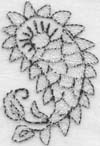Section 1 == *script chart*; *positional chart*; *more help*
The letter alif looks like a vertical line. At the beginning of a word, it can sound like the short vowels "a," "i," or "u." Or it can act as a place-holder helping either ye or vāʾo to function as a vowel (the former case is explained in section 1.5; the latter case, in section 2.2). In any other position, it sounds like the long vowel "aa." Remember that it's a non-connector.
The single most common pronunciation problem involving alif is really a grammatical one, and may be worth mentioning here. Because diacritics are rarely provided in Urdu, the two-letter word alif + sīn could be pronounced with any of the three official short vowels: as , is , or us . The first is not a word at all, but the two others are among the most common words in the language, being the oblique forms of yih (this) and vuh (that) respectively. When you are reading along, how do you know whether to opt for is or us ?
The choice is actually very simple, since it's not at all a 50-50 guess. In English we have separate pronoun sets for "this" and "that" versus "he, she, it." In Urdu, we don't; vuh and yih have to do it all. And in practice that means that vuh does the lion's share of the work: it's used for "he, she, it" and also for "that," while yih is used only for "this." Thus vuh is very much more common than yih , and its oblique form us also greatly predominates over is . The same is true of the oblique plural forms: un is far more common than in , and thus a much better guess for a first reading. The same is true for udhar (that way) and idhar (this way): think how much of the universe is off in some distance or direction away from you, compared to how little is right toward you or near you.
When a curly hat or madd ("extension") is applied above alif , it doubles its power. Thus at the beginning of a word, alif madd sounds like the long vowel aa. In the rare cases in which it occurs in the middle of a word, it not only sounds like aa but also forces the start of a new syllable. (For discussion of this effect, see section 11.2.) It never occurs at the end of a word. It is of course a non-connector.
The letters be ("b"); pe ("p"); te (dental "t"); ṭe (retroflex "T"); and ṡe ("s"), are always identical in shape, and differ only in their dots-- and in the retroflex marker on ṭe , which is shaped something like a small musical note (or a small letter t̤oʾe ). The letter ṡe is a relatively uncommon one; it is not the normal letter used for the "s" sound (which is in fact sīn ). We will look more closely at "s" letters in section 4.1.
The be series is the longest; but much more importantly, it's also the trickiest. Its letters have a remarkable variety of inconspicuous, relatively minimal forms that at first can be confusing to learn. Remember that this series is not typical-- in fact, quite the contrary: a good grasp of the be series represents at least half the whole task of learning the script.
The letter nūn
("n") occurs near the end of the alphabet, and is not
part of any series. It has a large round independent
form, and a similar final form, that are both quite
different from those of the be
series. However, its initial and medial forms entirely
mimic those of the be series, so
that in those forms it can be distinguished from a be -series letter only by its dots
(one dot above the letter). It is used for all nasals,
including the Devanagari nasals and half-"n" conjunct
forms (see section 9.2), and also for the retroflex "n"
(as in Varanasi), which is not separately shown in Urdu.
The letter chhoṭī ye (the long vowel "ii") also occurs near the end of the alphabet; its independent form is a beautiful swan-like shape. Its final form looks like the swan with its neck chopped off. However, the initial and medial forms of ye , like those of nūn , entirely mimic those of the be series, so that in those forms it can be distinguished from the be series only by its dots (two dots below the letter).
The letter chhoṭī ye is a semi-vowel, which means that it can sound either like a vowel ("ii," as in the honorific jī ) if it is the second letter in a syllable, or like a consonant ("y," as in yār ) if it is the first letter in a syllable. (Consider the somewhat parallel English instance of the vowel-"y" in "by," versus the consonant-"y" in "yes.") In words that begin with the vowel sound "ii," the chhoṭī ye must be preceded by alif , to protect it from becoming the first letter in a syllable and thus turning into consonant-"y."
(Note that the counterpart Devanagari letter, the long vowel "ii," is often called baṛī ī to distinguish it from its short-vowel counterpart "i." Thus in some positions the Devanagari baṛī ī corresponds to the Urdu chhoṭī ye , which does sound confusing. Such confusions are not common, however, On the whole, when learning Urdu it's a real help to know Devanagari script.)
See 3.3 for discussion of chhoṭī ye 's Siamese twin, baṛī ye , which is sometimes (in independent and final position) distinguishable from it, and sometimes (in initial and medial position) not distinguishable. Thus there are two vowel-ye sounds: the "ii" of chhoṭī ye , and the "e" or "ai" choice offered by baṛī ye . But there is only one consonant-ye sound: the syllable-starter "y."
